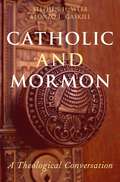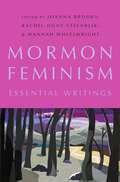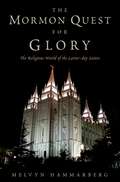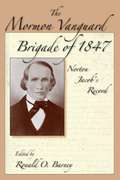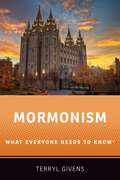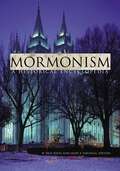- Table View
- List View
Moritz Steinschneider. The Hebrew Translations of the Middle Ages and the Jews as Transmitters: Vol I. Preface. General Remarks. Jewish Philosophers (Amsterdam Studies in Jewish Philosophy #16)
by Charles H. Manekin, Y. Tzvi Langermann and Hans Hinrich BiesterfeldtThis book deals with medieval Jewish authors who wrote in Arabic, such as Moses Maimonides, Judah Halevi, and Solomon Ibn Gabirol, as well as the Hebrew translations and commentaries of Judaeo-Arabic philosophy. It brings up to date a part of Moritz Steinschneider’s monumental Die hebraeischen Uebersetzungen des Mittelalters und die Juden als Dolmetscher (The Hebrew Translations of the Middle Ages and the Jews as Transmitters), which was first published in 1893 and remains to this day the authoritative account of the transmission and development of Arabic and Latin, and, by way of those languages, Greek culture to medieval and renaissance Jews. In the work presented here, Steinschneider’s bibliography has been updated, some of his scholarly judgments have been judiciously revised and an exhaustive listing of pertinent Hebrew manuscripts and their whereabouts has been provided. The volume opens with a long essay that describes the origin and genesis of Die Hebraeischen Übersetzungen, and with Steinschneider’s prefaces to the French and German versions of his work. This publication is the first in a projected series that translates, updates and, where necessary, revises parts of Steinschneider’s bio-bibliographical classic. Historians of medieval culture and philosophy, and also scholars of the transmission of classical culture to Muslims, Christians, and Jews, will find this volume indispensable.
Moritz Steinschneider. The Hebrew Translations of the Middle Ages and the Jews as Transmitters: Vol II. General Works. Logic. Christian Philosophers (Amsterdam Studies in Jewish Philosophy #18)
by Charles H. Manekin Hans Hinrich BiesterfeldtThis book surveys Hebrew manuscripts of Aristotelian philosophy and logic. It presents a translation and revision of part of Moritz Steinschneider’s monumental Die Hebraeischen Übersetzungen des Mittelalters und die Juden als Dolmetscher (The Hebrew Translations of the Middle Ages and the Jews as Interpreters). This resource was first published in 1893. It remains to this day the authoritative account of the transmission and development of Arabic and Latin, and, by way of those languages, Greek culture to medieval and renaissance Jews. The editors have updated Steinschneider’s bibliography. They have also judiciously revised some of his scholarly judgments. In addition, the volume provides an exhaustive listing of pertinent Hebrew manuscripts and their whereabouts. The section on logic, including texts hitherto unknown, represents the latest research in the history of medieval logic in Hebrew. This publication is the second in a series of volumes that translates, updates, and, where necessary, revises parts of Steinschneider’s bio-bibliographical classic work on Hebrew manuscripts of philosophical encyclopedias, manuals, and logical writings. Historians of medieval culture and philosophy, and also scholars of the transmission of classical culture to Muslims, Christians, and Jews, will find this volume indispensable.
MORMON & CATHOLIC C: A Theological Conversation
by Stephen H. Webb Alonzo L. GaskillWhat could Roman Catholicism and Mormonism possibly have to learn from each other? On the surface, they seem to diverge on nearly every point, from their liturgical forms to their understanding of history. With its ancient roots, Catholicism is a continuous tradition, committed to the conservation of the creeds, while Mormonism teaches that the landscape of Christian history is riddled with errors and apostasy and in need of radical revision and spiritual healing. Additionally, successful proselyting efforts by Mormons in formerly Catholic strongholds have increased opportunities for misunderstanding, polemic, and prejudice between the two faiths. However, as demonstrated in this unique and spirited dialogue between two theologians, one a convert to Catholicism and the other a convert to Mormonism, these two traditions are much closer to each other than many assume, including in their treatment of central doctrines such as authority, grace, Jesus, Mary, and revelation. Both Catholicism and Mormonism have ambitiously universal views of the Christian faith, and readers will be surprised by how close Catholics and Mormons are on a number of topics and how these traditions, probed to their depths, shed light on each other in fascinating and unexpected ways. Catholic and Mormon is an invitation to the reader to engage in a discussion that makes understanding the goal, and marks a beginning for a dialogue that will become increasingly important in the years to come.
Mormon Christianity: What Other Christians Can Learn From the Latter-day Saints
by Stephen H. WebbMormons are adamant that they are Christian, and eloquent writers within their own faith have tried to make this case, but no theologian outside the LDS church has ever tried to demonstrate just how Christian they are. Stephen H. Webb's Mormon Christianity: What Other Christians Can Learn from the Latter-day Saints fills this void, as the author writes neither as a critic nor a defender of Mormonism but as a sympathetic observer who is deeply committed to engaging with Mormon ideas. Webb is unique in taking Mormon theology seriously by showing how it provides plausible and in some instances even persuasive alternatives to many traditional Christian doctrines. His book can serve as an introduction to Mormonism, but it goes far beyond that: Webb explains how Mormonism is a branch of the Christian family tree that extends well beyond what most Christians have ever imagined. His account of their creative appropriation of the Christian tradition is meant to inspire more traditional Christians to reconsider the shape of many basic Christian beliefs. Mormon Christianity is not all affirming and celebratory. It ends with a call to Mormons to be more focused on Christian essentials and an invitation to other Christians to be more imaginative in considering Mormon alternatives to traditional doctrines.
Mormon Christianity: What Other Christians Can Learn From the Latter-day Saints
by Stephen H. WebbMormons are adamant that they are Christian, and eloquent writers within their own faith have tried to make this case, but no theologian outside the LDS church has ever tried to demonstrate just how Christian they are. Stephen H. Webb's Mormon Christianity: What Other Christians Can Learn from the Latter-day Saints fills this void, as the author writes neither as a critic nor a defender of Mormonism but as a sympathetic observer who is deeply committed to engaging with Mormon ideas. Webb is unique in taking Mormon theology seriously by showing how it provides plausible and in some instances even persuasive alternatives to many traditional Christian doctrines. His book can serve as an introduction to Mormonism, but it goes far beyond that: Webb explains how Mormonism is a branch of the Christian family tree that extends well beyond what most Christians have ever imagined. His account of their creative appropriation of the Christian tradition is meant to inspire more traditional Christians to reconsider the shape of many basic Christian beliefs. Mormon Christianity is not all affirming and celebratory. It ends with a call to Mormons to be more focused on Christian essentials and an invitation to other Christians to be more imaginative in considering Mormon alternatives to traditional doctrines.
The Mormon Culture of Salvation
by Douglas J. DaviesThe Mormon Culture of Salvation presents a comprehensive study of Mormon cultural and religious life, offering important new theories of Mormonism - one of the fastest growing movements and thought by many to be the next world religion. Bringing social, scientific and theological perspectives to bear on the Church of Jesus Christ of Latter-day Saints, Douglas Davies draws from theology, history of religions, anthropology, sociology and psychology to present a unique example of a truly interdisciplinary analysis in religious studies. Examining the many aspects of Mormon belief, ritual, family life and history, this book presents a new interpretation of the origin of Mormonism, arguing that Mormonism is rooted in the bereavement experience of Joseph Smith, which influenced the development of temple ritual for the dead and the genealogical work of many Mormon families. Davies shows how the Mormon commitment to work for salvation relates to current Mormon belief in conversion, and to traditional Christian ideas of grace. The Mormon Culture of Salvation is an important work for Mormons and non-Mormons alike, offering fresh insights into how Mormons see the world and work for their future glory in heavenly realms. Written by a non-Mormon with over 30 years' research experience into Mormonism, this book is essential reading for those seeking insights into new interdisciplinary forms of analysis in religion, as well as all those studying or interested in Mormonism and world religions. Douglas J. Davies is Professor in the Study of Religion in the Department of Theology, Durham University, UK. He is the author of many books including Death, Ritual and Belief (Cassell, 1997), Mormon Identities in Transition (Cassell, 1994), Mormon Spirituality (1987), and Meaning and Salvation in Religious Studies (Brill, 1984).
The Mormon Culture of Salvation
by Douglas J. DaviesThe Mormon Culture of Salvation presents a comprehensive study of Mormon cultural and religious life, offering important new theories of Mormonism - one of the fastest growing movements and thought by many to be the next world religion. Bringing social, scientific and theological perspectives to bear on the Church of Jesus Christ of Latter-day Saints, Douglas Davies draws from theology, history of religions, anthropology, sociology and psychology to present a unique example of a truly interdisciplinary analysis in religious studies. Examining the many aspects of Mormon belief, ritual, family life and history, this book presents a new interpretation of the origin of Mormonism, arguing that Mormonism is rooted in the bereavement experience of Joseph Smith, which influenced the development of temple ritual for the dead and the genealogical work of many Mormon families. Davies shows how the Mormon commitment to work for salvation relates to current Mormon belief in conversion, and to traditional Christian ideas of grace. The Mormon Culture of Salvation is an important work for Mormons and non-Mormons alike, offering fresh insights into how Mormons see the world and work for their future glory in heavenly realms. Written by a non-Mormon with over 30 years' research experience into Mormonism, this book is essential reading for those seeking insights into new interdisciplinary forms of analysis in religion, as well as all those studying or interested in Mormonism and world religions. Douglas J. Davies is Professor in the Study of Religion in the Department of Theology, Durham University, UK. He is the author of many books including Death, Ritual and Belief (Cassell, 1997), Mormon Identities in Transition (Cassell, 1994), Mormon Spirituality (1987), and Meaning and Salvation in Religious Studies (Brill, 1984).
Mormon Feminism: Essential Writings
by Joanna Brooks, Rachel Hunt Steenblik and Hannah WheelwrightThis groundbreaking collection gathers together for the first time the essential writings of the contemporary Mormon feminist movement--from its historic beginnings in the 1970s to its vibrant present, offering the best Mormon feminist thought and writing. No issue in Mormonism has made more headlines than the faith's distinctive approach to sex and gender. From its polygamous nineteenth-century past to its twentieth-century stand against the Equal Rights Amendment and its twenty-first-century fight against same-sex marriage, the Church of Jesus Christ of Latter-day Saints (LDS) has consistently positioned itself on the frontlines of battles over gender-related identities, roles, and rights. But even as the church has maintained a conservative position in public debates over sex and gender, Mormon women have developed their own brand of feminism by recovering the lost histories of female leadership and exploring the empowering potential of Mormon theology. The selections in this book-many gathered from out-of-print anthologies, magazines, and other ephemera--walk the reader through the history of Mormon feminism, from the second-wave feminism of the 1970s to contemporary debates over the ordination of women. Collecting essays, speeches, poems, and prose, Mormon Feminism presents the diverse voices of Mormon women as they challenge assumptions and stereotypes, push for progress and change in the contemporary LDS Church, and band together with other feminists of faith hoping to build a better world.
Mormon Feminism: Essential Writings
This groundbreaking collection gathers together for the first time the essential writings of the contemporary Mormon feminist movement--from its historic beginnings in the 1970s to its vibrant present, offering the best Mormon feminist thought and writing. No issue in Mormonism has made more headlines than the faith's distinctive approach to sex and gender. From its polygamous nineteenth-century past to its twentieth-century stand against the Equal Rights Amendment and its twenty-first-century fight against same-sex marriage, the Church of Jesus Christ of Latter-day Saints (LDS) has consistently positioned itself on the frontlines of battles over gender-related identities, roles, and rights. But even as the church has maintained a conservative position in public debates over sex and gender, Mormon women have developed their own brand of feminism by recovering the lost histories of female leadership and exploring the empowering potential of Mormon theology. The selections in this book-many gathered from out-of-print anthologies, magazines, and other ephemera--walk the reader through the history of Mormon feminism, from the second-wave feminism of the 1970s to contemporary debates over the ordination of women. Collecting essays, speeches, poems, and prose, Mormon Feminism presents the diverse voices of Mormon women as they challenge assumptions and stereotypes, push for progress and change in the contemporary LDS Church, and band together with other feminists of faith hoping to build a better world.
Mormon Identities in Transition (Religious Studies: Bloomsbury Academic Collections)
by Douglas DaviesThis collection of interdisciplinary essays explores the prime concern of Mormon Studies – the relationship between knowledge and spirituality – and how that relationship has been defined and reinterpreted over time. Beginning with an examination of the international prospects for Mormonism at the turn of the century, the volume's overarching theme, from sociological, anthropological and theological approaches, is the examination of changing Mormon identities.The contributors review the expansion of Mormonism, the emotional and social contexts of its historic and contemporary manifestations, the distinction between 'Utah' Mormons and the Reorganized Church of Jesus Christ of Latter Day Saints, and issues in Mormon feminism, concluding with a valuable review of the sources and documents available for studying Mormonism.
The Mormon Jesus: A Biography
by John G. TurnerFor two centuries, Jesus has connected the Latter-day Saints to broader currents of Christianity, even while particular Mormon beliefs have been points of differentiation. From the author of the definitive life of Brigham Young comes a biography of the Mormon Jesus that enriches our understanding of The Church of Jesus Christ of Latter-day Saints.
The Mormon Jesus: A Biography
by John G. TurnerFor two centuries, Jesus has connected the Latter-day Saints to broader currents of Christianity, even while particular Mormon beliefs have been points of differentiation. From the author of the definitive life of Brigham Young comes a biography of the Mormon Jesus that enriches our understanding of The Church of Jesus Christ of Latter-day Saints.
The Mormon Menace: Violence and Anti-Mormonism in the Postbellum South
by Patrick Mason"It incarnates every unclean beast of lust, guile, falsehood, murder, despotism and spiritual wickedness." So wrote a prominent Southern Baptist official in 1899 of Mormonism. Rather than the "quintessential American religion," as it has been dubbed by contemporary scholars, in the late nineteenth century Mormonism was America's most vilified homegrown faith. A vast national campaign featuring politicians, church leaders, social reformers, the press, women's organizations, businessmen, and ordinary citizens sought to end the distinctive Latter-day Saint practice of plural marriage, and to extinguish the entire religion if need be. Placing the movement against polygamy in the context of American and southern history, Mason demonstrates that anti-Mormonism was one of the earliest vehicles for reconciliation between North and South after the Civil War and Reconstruction. Southerners joined with northern reformers and Republicans to endorse the use of newly expanded federal power to vanquish the perceived threat to Christian marriage and the American republic. Anti-Mormonism was a significant intellectual, legal, religious, and cultural phenomenon, but in the South it was also violent. While southerners were concerned about distinctive Mormon beliefs and political practices, they were most alarmed at the "invasion" of Mormon missionaries in their communities and the prospect of their wives and daughters falling prey to polygamy. Moving to defend their homes and their honor against this threat, southerners turned to legislation, to religion, and, most dramatically, to vigilante violence. The Mormon Menace provides new insights into some of the most important discussions of the late nineteenth century and of our own age, including debates over the nature and limits of religious freedom; the contest between the will of the people and the rule of law; and the role of citizens, churches, and the state in regulating and defining marriage.
The Mormon Menace: Violence and Anti-Mormonism in the Postbellum South
by Patrick Mason"It incarnates every unclean beast of lust, guile, falsehood, murder, despotism and spiritual wickedness." So wrote a prominent Southern Baptist official in 1899 of Mormonism. Rather than the "quintessential American religion," as it has been dubbed by contemporary scholars, in the late nineteenth century Mormonism was America's most vilified homegrown faith. A vast national campaign featuring politicians, church leaders, social reformers, the press, women's organizations, businessmen, and ordinary citizens sought to end the distinctive Latter-day Saint practice of plural marriage, and to extinguish the entire religion if need be. Placing the movement against polygamy in the context of American and southern history, Mason demonstrates that anti-Mormonism was one of the earliest vehicles for reconciliation between North and South after the Civil War and Reconstruction. Southerners joined with northern reformers and Republicans to endorse the use of newly expanded federal power to vanquish the perceived threat to Christian marriage and the American republic. Anti-Mormonism was a significant intellectual, legal, religious, and cultural phenomenon, but in the South it was also violent. While southerners were concerned about distinctive Mormon beliefs and political practices, they were most alarmed at the "invasion" of Mormon missionaries in their communities and the prospect of their wives and daughters falling prey to polygamy. Moving to defend their homes and their honor against this threat, southerners turned to legislation, to religion, and, most dramatically, to vigilante violence. The Mormon Menace provides new insights into some of the most important discussions of the late nineteenth century and of our own age, including debates over the nature and limits of religious freedom; the contest between the will of the people and the rule of law; and the role of citizens, churches, and the state in regulating and defining marriage.
The Mormon Quest for Glory: The Religious World of the Latter-day Saints
by Melvyn HammarbergThe Church of Jesus Christ of Latter-day Saints has 6 million members in the United States today (and 13 million worldwide). Yet, while there has been extensive study of Mormon history, comparatively little scholarly attention has been paid to contemporary Mormons. The best sociological study of Mormon life, Thomas O'Dea's The Mormons, is now over fifty years old. What is it like to be a Mormon in America today? Melvyn Hammarberg attempts to answer this question by offering an ethnography of contemporary Mormons. In The Mormon Quest for Glory, Hammarberg examines Mormon history, rituals, social organization, family connections, gender roles, artistic traditions, use of media, and missionary work. He writes as a sympathetic outsider who has studied Mormon life for decades, and strives to explain the religious world of the Latter-day Saints through the lens of their own spiritual understanding. Drawing on a survey, participant observation, interviews, focus groups, attendance at religious gatherings, diaries, church periodicals, lesson manuals, and other church literature, Hammarberg aims to present a comprehensive picture of the religious world of the Latter-day Saints.
The Mormon Quest for Glory: The Religious World of the Latter-day Saints
by Melvyn HammarbergThe Church of Jesus Christ of Latter-day Saints has 6 million members in the United States today (and 13 million worldwide). Yet, while there has been extensive study of Mormon history, comparatively little scholarly attention has been paid to contemporary Mormons. The best sociological study of Mormon life, Thomas O'Dea's The Mormons, is now over fifty years old. What is it like to be a Mormon in America today? Melvyn Hammarberg attempts to answer this question by offering an ethnography of contemporary Mormons. In The Mormon Quest for Glory, Hammarberg examines Mormon history, rituals, social organization, family connections, gender roles, artistic traditions, use of media, and missionary work. He writes as a sympathetic outsider who has studied Mormon life for decades, and strives to explain the religious world of the Latter-day Saints through the lens of their own spiritual understanding. Drawing on a survey, participant observation, interviews, focus groups, attendance at religious gatherings, diaries, church periodicals, lesson manuals, and other church literature, Hammarberg aims to present a comprehensive picture of the religious world of the Latter-day Saints.
Mormon Trail, The: Yesterday and Today
by William HillBack in print, this essential reference for readers interested in the Mormon Trail is part history, part resource book, part guide and photographic essay. It includes an historical introduction, a chronology, excerpts from trail diaries, along with maps, over 200 then-and-now photos, and descriptions of major museums and displays along the trail. By the author of previous volumes on the Oregon, California, and Santa Fe trails.
Mormon Vanguard Brigade Of 1847: Norton Jacob's Record
by Ronald O. Barney Norton JacobThere are no historical events that have more iconic significance for the people of Utah than the trek of the vanguard company of Mormons west in 1847. Its meaning may vary, but overall, the march has a highly symbolic and seminal historical importance for virtually all Utahns. While the journey has been widely celebrated, memorialized, and even sanctified and various books have been written about it, there is more that can be said and understood about the migration's place in western history; about its context, including events preceding and following it; and about the real experiences of its participants. Particularly lacking in most published accounts are the stories of the rank and file members, the individuals who, in contrast to the well-known leadership, with Brigham Young at the top, might fittingly be called foot soldiers. The 1847 company had a military-like organization, which is captured by Ronald Barney's term brigade in the title. Norton Jacob was such a man of the ranks in 1847. He had no special status in the Mormon Church, and there was little to make him stand out in the historical record than that he left what is regarded by many trail historians as one of the best and most informative journals of the early Mormon emigration. While the heart of Jacob's record concerns the 1847 journey, there is much more to it. The diary published here begins in 1844, the year of church founder Joseph Smith's murder. It continues through the crisis events that followed: the Mormons' flight from Nauvoo, their trudging journey across Iowa to Winter Quarters, and the beginnings of mass migration to Utah. After the apex of 1847, the arc of the narrative moves through accounts of Jacob's return to Nauvoo late that year and of the much larger Mormon emigration in 1848. It reaches denouement in a short record of his first years in Salt Lake Valley.
Mormon Visual Culture and the American West (Routledge Research in Art and Religion)
by Nathan ReesThis book explores the place of art in Latter-day Saint society during the first 50 years of the Utah settlement, beginning in 1847. Nathan Rees uncovers the critical role that images played in nineteenth-century Mormon religion, politics, and social practice. These artists not only represented, but actively participated in debates about theology, politics, race, gender, and sexuality at a time when Latter-day Saints were grappling with evolving doctrine, conflict with Native Americans, and political turmoil resulting from their practice of polygamy. The book makes an important contribution to art history, Mormon studies, American studies, and religious studies.
Mormon Visual Culture and the American West (Routledge Research in Art and Religion)
by Nathan ReesThis book explores the place of art in Latter-day Saint society during the first 50 years of the Utah settlement, beginning in 1847. Nathan Rees uncovers the critical role that images played in nineteenth-century Mormon religion, politics, and social practice. These artists not only represented, but actively participated in debates about theology, politics, race, gender, and sexuality at a time when Latter-day Saints were grappling with evolving doctrine, conflict with Native Americans, and political turmoil resulting from their practice of polygamy. The book makes an important contribution to art history, Mormon studies, American studies, and religious studies.
Mormonism: A Very Short Introduction (Very Short Introductions)
by Richard Lyman BushmanBeginning with a handful of members in 1830, the church that Joseph Smith founded has grown into a world-wide organization with over 12 million adherents, playing prominent roles in politics, sports, entertainment, and business. Yet they are an oddity. They are considered wholesome, conservative, and friendly on one hand, and clannish, weird, and self-righteous on the other. Mormonism: A Very Short Introduction explains who Mormons are: what they believe and how they live their lives. Written by Richard Lyman Bushman, an eminent historian and practicing Mormon, this compact, informative volume ranges from the history of the Church of Jesus Christ of Latter-day Saints to the contentious issues of contemporary Mormonism. Bushman argues that Joseph Smith still serves as the Mormons' Moses. Their everyday religious lives are still rooted in his conceptions of true Christianity. They seek revelation to solve life's problems just as he did. They believe the authority to seal families together for eternity was restored through him. They understand their lives as part of a spiritual journey that started in a "council in heaven" before the world began just as he taught. Bushman's account also describes the tensions and sorrows of Mormon life. How are Mormons to hold on to their children in a world of declining moral standards and rampant disbelief? How do rational, educated Mormons stand up to criticisms of their faith? How do single Mormons fare in a church that emphasizes family life? The book also examines polygamy, the various Mormon scriptures, and the renegade fundamentalists who tarnish the LDS image when in fact they're not members. In a time when Mormons such as Mitt Romney and Harry Reid are playing prominent roles in American society, this engaging introduction enables readers to judge for themselves how Mormon teachings shape the character of believers. About the Series: Oxford's Very Short Introductions series offers concise and original introductions to a wide range of subjects--from Islam to Sociology, Politics to Classics, Literary Theory to History, and Archaeology to the Bible. Not simply a textbook of definitions, each volume in this series provides trenchant and provocative--yet always balanced and complete--discussions of the central issues in a given discipline or field. Every Very Short Introduction gives a readable evolution of the subject in question, demonstrating how the subject has developed and how it has influenced society. Eventually, the series will encompass every major academic discipline, offering all students an accessible and abundant reference library. Whatever the area of study that one deems important or appealing, whatever the topic that fascinates the general reader, the Very Short Introductions series has a handy and affordable guide that will likely prove indispensable.
Mormonism: What Everyone Needs to Know® (What Everyone Needs To KnowRG)
by Terryl GivensMormonism, or the Church of Jesus Christ of Latter-day Saints, is America's most successful-and most misunderstood-home grown religion. The church today boasts more than 15 million members worldwide, a remarkable feat in the face of increasing secularity. The growing presence of Mormonism shows no signs of abating, as the makeup of its membership becomes progressively diverse. The heightened contemporary relevance and increasingly global membership of the Church solidifies Mormonism as a religious group much deserving of awareness. Covering the origins, history, and modern challenges of the church, Mormonism: What Everyone Needs to Know offers readers a brief, authoritative guide to one of the fastest growing faith groups of the twenty-first century in a reader-friendly format, providing answers to questions such as: What circumstances gave rise to the birth of Mormonism? Why was Utah chosen as a place of refuge? Do you have to believe the Book of Mormon to be a Latter-day Saint? Why do women not hold the priesthood? How wealthy is the church and how much are top leaders paid? Written by a believer and the premier scholar of the Latter-day Saints faith, this remarkably readable introduction provides a sympathetic but unstinting account of one of the few religious traditions to maintain its vitality and growth in an era of widespread disaffiliation.
Mormonism: A Guide for the Perplexed (Guides for the Perplexed #330)
by Robert L. Millet Shon D. HopkinMormonism: A Guide for the Perplexed explains central facets of the Mormon faith and way of life for those wishing to gain a clearer understanding of this rapidly growing world religion. As The Church of Jesus Christ of Latter-day Saints continues to grow in the United States and especially in other countries (with a total membership of over 15 million, more than 50% of which is outside the US), and as theologians and church leaders wrestle with whether Mormonism is in fact a valid expression of modern Christianity, this distinctive religious tradition has become increasingly an object of interest and inquiry.This book is the ideal companion to the study of this perplexing and often misunderstood religion. Covering historical aspects, this guide takes a careful look at the whole of Mormonism, its tenets and practices, as well as providing an insight into a Mormon life.
Mormonism: A Guide For The Perplexed (Guides for the Perplexed #330)
by Robert L. Millet Shon D. HopkinMormonism: A Guide for the Perplexed explains central facets of the Mormon faith and way of life for those wishing to gain a clearer understanding of this rapidly growing world religion. As The Church of Jesus Christ of Latter-day Saints continues to grow in the United States and especially in other countries (with a total membership of over 15 million, more than 50% of which is outside the US), and as theologians and church leaders wrestle with whether Mormonism is in fact a valid expression of modern Christianity, this distinctive religious tradition has become increasingly an object of interest and inquiry.This book is the ideal companion to the study of this perplexing and often misunderstood religion. Covering historical aspects, this guide takes a careful look at the whole of Mormonism, its tenets and practices, as well as providing an insight into a Mormon life.
Mormonism: A Historical Encyclopedia
by W. Paul Reeve Ardis E. ParshallCovering its historic development, important individuals, and central ideas and issues, this encyclopedia offers broad historical coverage of The Church of Jesus Christ of Latter-day Saints.Mormonism: A Historical Encyclopedia helps readers explore a church that has gone from being an object of ridicule and sometimes violent persecution to a worldwide religion, counting prominent businesspeople and political leaders among its members (including former Massachusetts governor and recent presidential candidate Mitt Romney).The encyclopedia begins with an overview of The Church of Jesus Christ of Latter-day Saints—six essays cover the church's history from Joseph Smith's first vision in 1820 to its current global status. This provides a context for subsequent sections of alphabetically organized entries on key events and key figures in Mormon history. A final section looks at important issues such as the church's organization and government, its teachings on family, Mormonism and blacks, Mormonism and women, and Mormonism and Native Americans. Together, these essays and entries, along with revealing primary sources, portray the Mormon experience like no other available reference work.


